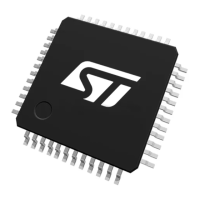Power control (PWR) RM0444
126/1390 RM0444 Rev 5
4.3 Low-power modes
By default, the microcontroller is in Run mode after a system or a power Reset. Several low-
power modes are available to save power when the CPU does not need to be kept running,
for example when waiting for an external event. It is up to the user to select the mode that
gives the best compromise between low-power consumption, short startup time and
available wakeup sources.
The device features seven low-power modes:
• Sleep mode: CPU clock off, all peripherals including Cortex
®
-M0+ core peripherals
such as NVIC, SysTick, etc. can run and wake up the CPU when an interrupt or an
event occurs. Refer to Section 4.3.4: Sleep mode.
• Low-power run mode: This mode is achieved when the system clock frequency is
reduced below 2 MHz. The code is executed from the SRAM or the Flash memory. The
regulator is in low-power mode to minimize the regulator's operating current. Refer to
Section 4.3.2: Low-power run mode (LP run).
• Low-power sleep mode: This mode is entered from the Low-power run mode: Cortex
®
-
M0+ is off. Refer to Section 4.3.5: Low-power sleep mode (LP sleep).
• Stop 0 and Stop 1 modes: SRAM and all registers content are retained. All clocks in the
V
CORE
domain are stopped, the PLL, the HSI16 and the HSE are disabled. The LSI
and the LSE can be kept running.
The RTC and TAMP can remain active (Stop mode with RTC, Stop mode without RTC).
Some peripherals with the wakeup capability can enable the HSI16 RC during the Stop
mode to detect their wakeup condition.
In Stop 0 mode, the main regulator remains ON, which allows the fastest wakeup time
but with higher consumption. The active peripherals and wakeup sources are the same
as in Stop 1 mode.
The system clock, when exiting Stop 0 or Stop 1 mode, is the HSISYS clock. If the
device is configured to wake up in Low-power run mode, the HSIDIV bits in RCC_CR
register must be configured prior to entering Stop mode to provide a frequency not
greater than 2 MHz.
Refer to Section 4.3.6: Stop 0 mode for details on Stop 0 mode.
• Standby mode: V
CORE
domain is powered off.
However, it is possible to preserve SRAM content:
– Standby mode with SRAM retention when the bit RRS is set in PWR_CR3 register.
In this case, SRAM is supplied by the low-power regulator.
– Standby mode when the bit RRS is cleared in PWR_CR3 register. In this case the
main regulator and the low-power regulator are powered off.
All clocks in the V
CORE
domain are stopped and the PLL, the HSI16, and the HSE
oscillators are disabled. The LSI and the LSE oscillators can be kept running.
The RTC can remain active (Standby mode with RTC, Standby mode without RTC).
The system clock, when exiting Standby modes, is the HSI16 oscillator clock.
Refer to Section 4.3.8: Standby mode.
• Shutdown mode: V
CORE
domain is powered off. All clocks in the V
CORE
domain are
stopped, the PLL, the HSI16, the LSI and the HSE oscillators are disabled. The LSE
can be kept running. The system clock, when exiting Shutdown mode, is the HSI16
oscillator clock. In this mode, the supply voltage monitoring is disabled and the product

